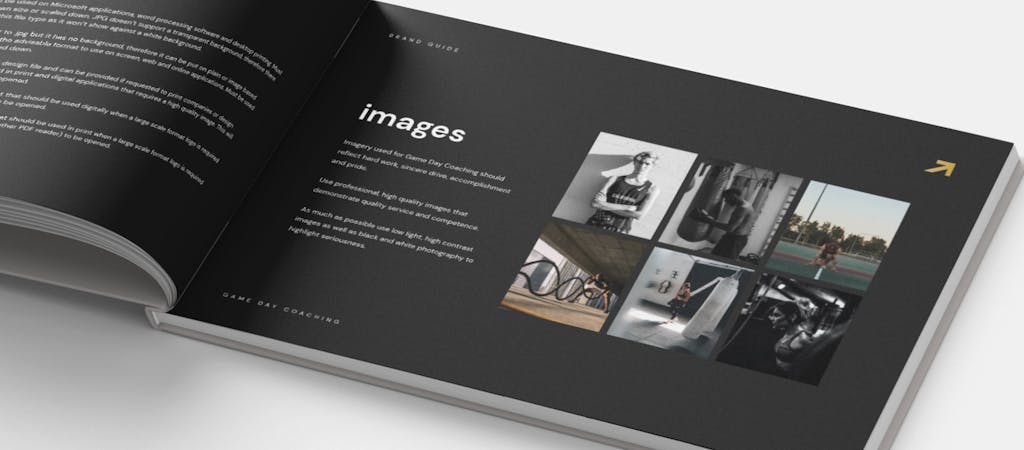Want your brand to be consistent and easily recognisable in the market? Here’s the top 5 things to include in your brand guide to get you started.
I often get asked, ‘what can I do to build a strong brand?’ My answer is always this: start with a brand guide that takes all the elements of your brand identity and translates it into one simple document.
The purpose of the brand guide is to communicate how to properly execute your brand and uphold consistency. Now, you might be wondering, what exactly should go into your brand guide? Below, we’ll walk you through how we’ve helped our clients whip up a killer brand guide for their business. Read on for our top tips:
1. logo
Let’s start with the most obvious inclusion, your logo. Have you thought about how it’s going to look in different environments, or as we like to say ‘in the wild’?
The logo section of your brand guidelines should display all the variables of your logo to ensure it is used in the way you [or your graphic designer] has intended. This also prevents misuse such as stretching or distorting, and ensures you have sufficient spacing around the logo etc.
Take a peek at our client, Game Day’s, brand guide below to see why it’s crucial to include all approved versions of your logo, along with clear instructions on when to use each one.

2. colour palette
Defining the colour palette only requires a quick reference. Most brands only choose four or less hues and do not deviate from these defined colours, except in opacity.
In your brand guide, provide the information needed to reproduce these colours.
- Colour match: PANTONE name and number
- Print colour: CMYK
- Digital colour: RGB and HEX codes
3. typography
An often overlooked part of brand identity is typography, or in other words, what fonts your brand will use. There’s a whole science behind brand typography but here’s a couple of quick tips:
Start with a font which will be used primarily for titles, this could be big, bold and eye-catching, but doesn’t have to be.
After this you can choose to add another typeface or choose the same as the title. It’s important not to choose more than 2 typefaces for headings, subheadings and body text for legible text paragraphs and consistency in your brand, but feel free to experiment with the thickness and sizing of the typeface[s] to add hierarchy.

4. imagery
Imagery is one of the most important elements of marketing, full stop. Imagery is evoking and the right type of imagery is priceless. Megabrands use every feature of their imagery, down to the hue to represent their brand and impress their look into the mind of their consumers.
Us humans are visual creatures. Images capture the imagination of your audience and help to give context. Unfortunately, many businesses don’t understand the importance of using good imagery. The right styling and consistent imagery will not only convey quality but also help tell your business’ story and create seamless alignment across your brand.
If you don’t have your own imagery and are instead using stock images, it’s beneficial to create a mood board to illustrate the best practices when it comes to your brand’s imagery.

5. your brand story
Every great brand is driven by a truly compelling story. Today, so many things around us are automated and digitalised and missing that human connection, this makes it even more important to create a brand that has a relatable story. That story is the foundation of your brand. The brand story provides context, so if anyone picks up your brand guide they should understand what your brand stands for right away.
Are you thinking, ‘but my brand does not have a brand story’? Then use this simple framework to compose yours.
Business vision
Your vision is a set of ideas that describe the progression towards a future goal. Vision statements get the business owners and leaders thinking about their aspiration and final destination once their business vision has been fulfilled. Be imaginative.
Business mission
Your mission statement is the why. It should describe why your business actually exists. It should be short and clear. For example, Walt Disney’s mission statement was ‘To Make People Happy’.
Business core values
This part is pretty self-explanatory. What does your business value? Something that it will incorporate into your service/product offering and keep at the forefront of your business? Is it dependability, consistency, flexibility?
5. tone of voice
So many businesses overlook how they need to actually speak to their audience. You need to meet your customers where they are. Your brand voice widely affects how your customers will think about you. It’s important to define what your brand voice is, but also what your brand voice is not, to ensure you’re appealing to your specifc audience. Build on your brand persona, think about how your brand would speak.
Include phrases, buzzwords, examples of paragraphs that represent your brand and have worked in the past. Make sure you apply this consistently throughout all your content and marketing activities.
Hooray! You are done, now the fun work begins.
The businessDEPOT Marketing team love helping businesses build a strong brand – it’s kind of our jam! With a team of graphic designers and marketing specialists we’ll help you develop a new brand identity and a brand guide to boot! Or if you just want to get some advice on improving your brand, reach out to us at marketing@businessdepot.com.au or give us a buzz on 1300BDEPOT!
get more marketing insights
If you found these tips useful and you’d like to get more information on all things marketing, you can sign up to our mailing box here!





















































